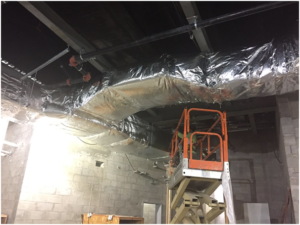Ductwork is used in many different heating and ventilation applications including air conditioning, central heating and extraction systems. Spiral ducting is the most frequently used type as it is light and flexible and easy to adapt to different applications and requirements. But have you ever stopped to consider how this type of duct is made and what it’s made of?

Materials
Spiral duct is usually made from galvanised steel – galvanising is a process that coats the metal in layers of zinc to prevent it corroding https://www.wisegeek.com/what-is-galvanized-steel.htm. It also gives the surface a silvery grey finish which is not unattractive and therefore doesn’t always need additional decorative treatment depending on the application. In some cases ducting is hidden away above false ceilings, etc., but it can be left exposed too. Exposed ducts are most common in factories and warehouses, but architects often choose to leave ducts exposed as a feature in other buildings like shops, offices or exhibition centres.
While galvanised ducting is most common, aluminium is frequently used too. This is because it’s lightweight and can be more easily stretched and bent during installation. Less common is stainless steel ducting. This is stronger than aluminium but is more expensive, however, its greater corrosion and abrasion resistance means it’s often used in harsh industrial environments and laboratories.

Whatever kind of material you are looking for, you can find spiral ducts here to suit most needs.
Making a spiral duct
The process of making a duct starts with the raw metal. This is usually supplied as a coil directly from the mill. The first step in the manufacturing process is to cut this into smaller, narrower coils known as ‘slit coils’.
To make the spiral duct, the slit coil is placed on a machine that uncoils it and levels it in order to flatten the material. It is then fed through a tube forming machine, this rolls the metal into a spiral and the edges are either welded or crimped to form the shape of the duct. This is a continuous process and the finished duct can simply be cut from the machine to the length required by the customer.
Depending on how and where it is going to be used, the finished duct may receive a surface coating or paint before going to the customer for its final installation.







